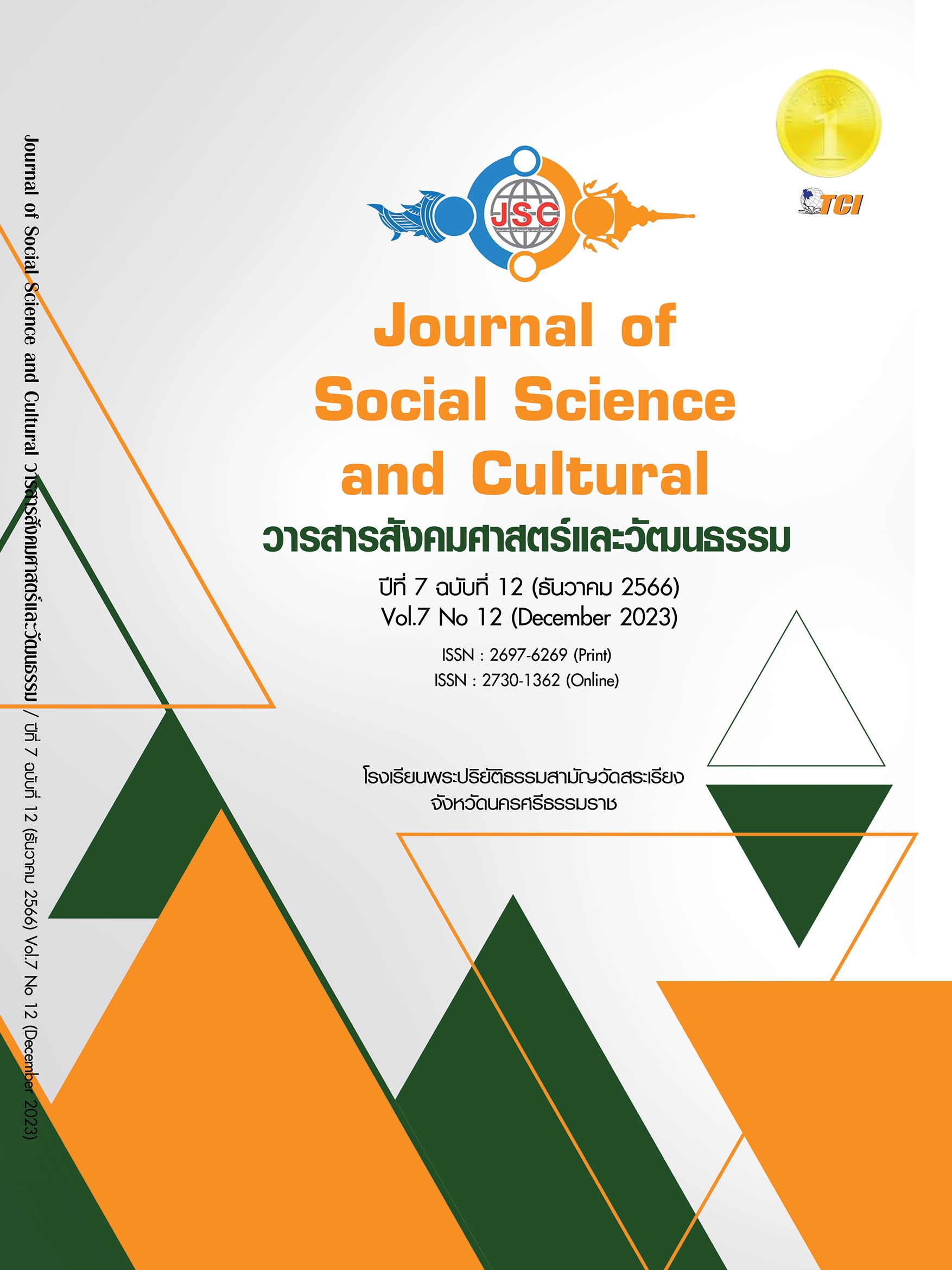USE OF MODELLING TECHNIQUE AND SIGN LANGUAGE VDO EXERCISE TO IMPROVE SIGN LANGUAGE VOCABULARY MEMORY OF A STUDENT WITH DEAFNESS AND INTELLECTUAL DISABILITIES
Main Article Content
Abstract
The purpose of this research was to develop the memory ability of a student with deafness and intellectual disabilities by using modelling technique with sign language VDO exercises. The case study, female aged 11 years with an Intelligence Quotient level of 36, was selected based on a purposive sampling. The tools used in the research were 1) a pre- and post-test, 2) four individualized implementation plans, namely: Plan 1: My Name; Plan 2: My Favorite Snack; Plan 3: My Father; and Plan 4: My Mother. The selected sign language vocabularies were easy and necessary for the daily life of case study in order to create sign language VDO exercise in all four individualized implementation plans. Data were analyzed by using frequencies, percentages, mean and descriptive analysis. The results of research indicated that the case study had increased ability to memorize sign language vocabulary. A pretest mean score was 11.50 and a posttest mean score was 29.75, with a difference of 18.25 point (36.50 %). And the average score in identifying pictures from memorizing sign language vocabulary according to all 4 individualized implementation plans revealed as follows: 1) Plan 1: it was found that a vocabulary memory score of the case study at a pretest was 40 % and a score at a posttest was 80 %, which was at a very good level. 2) Plan 2: was found that a vocabulary memory score of the case study at a pretest was 50 % and a score at a posttest was 60 %, which was at a good level. 3) Plan 3: it was found that a vocabulary memory score of the case study at a pretest was 20 % and a score at a posttest was 70 %, which was at a good level. 4) Plan 4: it was found that a vocabulary memory score of the case study at a pretest was 20 % and a score at a posttest was 60 %, which was at a good level.
Article Details
References
ณัฐวรินทร์ แซ่จุง. (2557). ความรู้เบื้องต้นเกี่ยวกับบุคคลที่มีความบกพร่องทางสติปัญญา. สงขลา: แอลเอแม็กการพิมพ์.
ทิศนา แขมมณี. (2561). ศาสตร์การสอน (พิมพ์ครั้งที่ 22). กรุงเทพมหานคร: สำนักพิมพ์จุฬาลงกรณ์มหาวิทยาลัย.
ธีรธร เลอศิลป์. (2558). การสื่อความหมายสำหรับเด็กที่มีความบกพร่องทางการได้ยิน. เชียงใหม่: คณะครุศาสตร์ มหาวิทยาลัยราชภัฏเชียงใหม่.
ธีรวัฒน์ กำเนิดศิริ และคณะ. (2553). โครงการวิจัยและพัฒนา โปรแกรมสอนภาษามือด้วยภาพเคลื่อนไหว 3 มิติ เพื่อส่งเสริมศักยภาพการเรียนรู้คำศัพท์ภาษาไทย อังกฤษของนักเรียนที่มีความบกพร่องทางการได้ยิน กรณีศึกษา . ใน รายงานการวิจัยมหาวิทยาลัยเชียงใหม่. โรงเรียนโสตศึกษาอนุสารสุนทร เชียงใหม่.
ประกาศกระทรวงศึกษาธิการ เรื่อง กำหนดประเภทและหลักเกณฑ์ของคนพิการทางการศึกษา พ.ศ. 2552. (2552). ราชกิจจานุเบกษา เล่ม 126 ตอนพิเศษ 80 ง หน้า 45 (8 มิถุนายน 2551).
ปรียาพร วงค์อนุตรโรจน์. (2551). จิตวิทยาการศึกษา. กรงเทพมหานคร: ศูนย์สื่อเสริมกรุงเทพ.
ผ่องพรรณ เกิดพิทักษ์. (2536). การปรับพฤติกรรมเบื้องต้น. กรุงเทพมหานคร: ทบวงมหาวิทยาลัย.
พระราชบัญญัติการจัดการศึกษาสำหรับคนพิการ พ.ศ. 2551. (2551). ราชกิจจานุเบกษา เล่ม 125 ตอนที่ 28 ก หน้า 4 (5 กุมภาพันธ์ 2551).
พระราชบัญญัติการศึกษาแห่งชาติ พ.ศ. 2542. (2542). ราชกิจจานุเบกษา เล่มที่ 116 ตอนที่ 74 ก หน้า 1 (19 สิงหาคม 2542).
มะลิวัลย์ ธรรมแสง. (2554). การศึกษาในเด็กที่มีความบกพร่องทางการได้ยินในประเทศไทย. เรียกใช้เมื่อ 20 พฤศจิกายน 2562 จาก https://www.deafthai.org/wp-content/uploads/2018/05/.PDF
มานะ ประทีปพรศักดิ์. (2548). สื่อการเรียนการสอนสำหรับคนหูหนวก. วารสารวิทยาลัยราชสุดาเพื่อการวิจัยและพัฒนาคนพิการ, 1(2), 28-36.
รัฐธรรมนูญแห่งราชอาณาจักรไทย พ.ศ. 2560. (2560). ราชกิจจานุเบกษา เล่ม 134 ตอนที่ 40 ก (6 เมษายน 2560).
ศรียา นิยมธรรม. (2544). ความบกพร่องทางการได้ยิน ผลกระทบทางจิตวิทยา การศึกษาและสังคม (พิมพ์ครั้งที่ 3). กรุงเทพมหานคร: คณะศึกษาศาสตร์ มหาวิทยาลัยศรีนครินทรวิโรฒ ประสานมิตร.
สำนักบริหารงานการศึกษาพิเศษ. (2565). ระบบสารสนเทศการศึกษาพิเศษ และการศึกษาสงเคราะห์. เรียกใช้เมื่อ 20 สิงหาคม 2565 จาก http://www.specialset.bopp.go.th/set_index/index.php
อัชรา เอิบสุขสิริ. (2561). จิตวิทยาสำหรับครู (พิมพ์ครั้งที่ 4). กรุงเทพมหานคร: สำนักพิมจุฬาลงกรณ์มหาวิทยาลัย.
Lederberg, A. et al. (2013). Language and Literacy Development of Deaf and Hard of Hearing Children: Successes and Challenges. Retrieved November 2 , 2022, from https://psycnet. apa.org/record/2012-20365-001.pdf
Rowland, C. (1994). Communication matrix questions and answer options. Retrieved November 2, 2022, from https://aaccommunity.net/wp - content/uploads/2019/03/ Communication-Matrix-Questions.pdf
World Health Organization. (2014). Deafness and Hearing Loss. Retrieved July 3, 2021, from https:// www.who.int/news-room/fact-sheets/detail/deafness-and-hearing-loss.S


